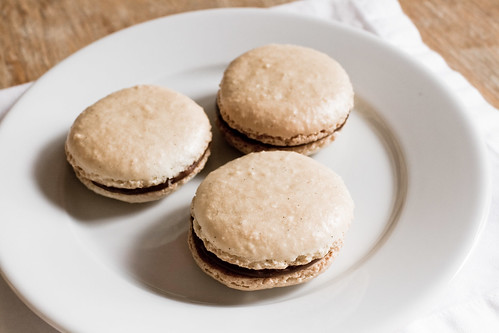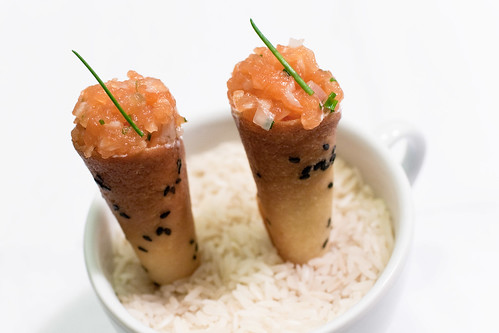For Valentine's Day, in lieu of going out to a crowded restaurant, we like to stay in and have a fancy dinner at home. It's the one time of year when I take the time to do excessively fancy dishes that just aren't practical to do every day at home. Typically, Emily will pick out a fancy dessert that reminds me that I am not a pastry chef, and we come up with a couple of savory courses to go with it. The meal usually includes "Oysters and Pearls" from the French Laundry Cookbook and an entrée.
This year I went a little overboard and spent most of the weekend cooking.
On Sunday morning, I made macarons as a surprise for Emily. I used the recipe from the Bouchon Cookbook for the cookies and filled them with the chocolate/caramel buttercream from our dessert. The dough spread a little, yielding larger cookies, but I think they turned out well for a first attempt. (The buttercream was a little loose too, making them messy to eat at room temperature.)
As an amuse bouche, I also made a small (1-egg) batch of gougères—cheese puffs made with Comté cheese. I wasn't planning on making them, but they're pretty easy to throw together and have been on my to-do list forever. They turned out fairly well but were a little denser than I'd like. I think the dough needed a little more egg and some tweaks to the cooking time.
For an appetizer, we decided it was about time to try making the Salmon Cornets from the French Laundry Cookbook. They're adorable little savory "ice cream" cones filled with a red onion crème fraîche (French sour cream) and topped with salmon tartare.
It's a great dish, but people on the internet reported having a lot of trouble making it. The tricky part is making the cones themselves. You bake 4" diameter disks of batter in a 400˚ oven until they are just set. Then pull the sheet pan out a little, flip over disks of molten batter, wrap them around conical molds, and finish baking then until they set. To avoid burning myself, I did most of the work with a mini offset spatula. However, I found that I needed to use my fingers to get the disk wrapped around the cone.
The results were worth the effort; it was my favorite dish of the night.
Next, I made our traditional Oysters and Pearls. This year it was good but not as good as previous years. The base was not thick enough, so the oysters sank in, instead of resting on top. (I had extra oysters and managed to get Emily's dish photo-ready by resting a second pair of oysters on top of the first.)
The base is a mixture of pearl tapioca, a savory sabayon (foamy cooked egg yolks), crème fraîche, and whipped cream. On top are two oysters, some caviar, and a foamy beurre blanc containing butter, shallots, chives, vermouth, vinegar, and oyster juice.
Our main course was another dish from the French Laundry Cookbook: a butter-poached lobster with pommes Maxim (crisp sheets of potato), leeks, and beet essence. Keller likes to steep lobster in hot water for a few minutes to remove the meat and then poach it to order in beurre monté. Beurre monté is essentially a bunch of butter that has been slowly whisked into a tiny bit of water. It is slightly tricky to work with, because it will separate if it gets too hot or too cold.
The pommes Maxim are thinly sliced potatoes that have been coated in clarified butter and baked into a thin, crisp sheet. The result is similar to a solid sheet of buttery potato chip, but I didn't quite get it right. The edges were rather dark but crisp, and the middle was a little leathery. It didn't crisp up right. I think I needed to dry the potato slices and back off on the butter. Nonetheless, I made extra and managed to get some decent pieces from the edge.
The beet reduction was tasty: beet juice reduced to a syrup, with some beurre monté and a splash of red wine vinegar whisked in. The vinegar complemented the sweetness of the beets, and the butter added a nice richness. On top of the sauce was a mixture of leeks, tomato diamonds (Keller cuts tomatoes into little diamonds), and "brunoise"—tiny cubes of carrot, parsnip, and leek greens. The brunoise mixture appears in a lot of French Laundry dishes. This was topped with half of a tail, a claw, and a shard of potato.
Emily chose the "Vanilla Fleur de Sel, Caramel and Chocolate Dobos Torte" from Cannelle et Vanille for dessert. It's a thin sponge cake layered with vanilla fleur de sel, chocolate, and caramel buttercream, topped with milk chocolate chantilly and caramel decorations. The torte itself wasn't terribly difficult, although it did take me a few hours on Saturday to put together.
Pastry is a bit outside my comfort zone, and Emily always finds something challenging for Valentine's Day. Two years ago, it was an Elizabeth Falkner recipe with a dozen components that I had to adjust for her allergies. Last year, it was a layered dessert, also from Cannelle et Vanille, with tempered white chocolate wrapped around it.
The real challenge for me this time was trying to form the caramel rings. The ingredient list for that recipe reads, "sugar." The rest is technique, which I don't have. Working with molten sugar makes me nervous, because it's tricky to work with and can cause severe burns. I carefully melted sugar in a pan until it was liquid and caramelized, then shocked the pan in an ice bath to lower the temperature, trying to get the sugar to just the right consistency so I could drizzle a ring of sugar around a greased metal measuring cup. If it's too hot, it pours too quickly and comes off as you get to the bottom side. If it's too cold, it seems to pour too thickly. Finally, I tried to remove the sugar from the form without mangling or breaking it. It took a lot of tries and some reheating and cooling of the pan, but I finally got a few acceptable rings. (I also got a pan with 1/4" of rock-hard caramel in the bottom.)








